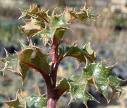Canyon Live Oak Tree Information
Images of Canyon Live Oak:






Canyon Live Oak grows in the following 6 states and provinces:
Arizona, California, Colorado, Maine, Nevada, OregonInformation about Canyon Live Oak:
The Quercus Chrysolepis is commonly known as the Canyon Live Oak, Dwarf Canyon Live Oak as well as Maul Oak.
The currently accepted scientific name of canyon live oak is Quercus chrysolepis Liebm. . Canyon live oak, which is intermediate between the white and black oak groups, is extremely variable both morphologically and ecologically . Recognized varieties are : Q. c. var. chrysolepis canyon live oak Q. c. var. nana (Jepson) Jepson dwarf canyon live oak Canyon live oak hybridizes with island oak (Q. tomentella), huckleberry oak (Q. vaccinifolia), and Palmer's oak (Q. palmeri) .Canyon live oak grows from southwestern Oregon through the Coast Ranges and Sierra Nevada to southern California and the mountains of Mexico . It is the most widely distributed of all California oaks and occurs across an estimated 1,121,000 acres (453,846 hectares) in California alone . Canyon live oak is rare east of the Cascade-Sierra crest but grows discontinuously on the eastern slopes of the southern and central Sierra Nevada . Scattered, disjunct populations occur in the mountains of southwestern Nevada and in parts of western and central Arizona, and Mexico . Fossil evidence suggests that this oak was much more widely distributed to the east during the late Wisconsin and early Holocene . The shrubby variety, Q. chrysolepis var. nana, occurs in California from Trinity County eastward to the Sierra Nevada , and throughout the Coast Ranges of northern California .Canyon live oak occurs in many types of plant communities and is reportedly found, although sometimes sparingly, in every forest type of California . It is a common component of mixed-evergreen forests made up of species such as Douglas-fir (Pseudotsuga menziesii), tanoak (Lithocarpus densiflorus), chinquapin (Chrysolepsis chrysophylla), and Pacific madrone (Arbutus menziesii) . Canyon live oak also grows in chaparral, montane chaparral, oak (Quercus spp.) woodlands, cypress (Cupressus spp.) stands, and pinyon-juniper-oak (Pinus-Juniperus-Quercus spp.) woodlands . It grows in riparian areas in parts of California, in oasis woodlands, and in higher elevation desert communities . This oak grows intermixed with Douglas-fir in the north and bigcone Douglas-fir (Pseudotsuga macrocarpa) in the south . Canyon live oak occasionally occurs with white fir (Abies concolor) in higher elevation forests of northern California . Dwarf canyon live oak is most commonly associated with chaparral . Canyon live oak is listed as an indicator of dominance or subdominance in the following community types or plant associations: Description and classification of the forests of the upper Illinois River drainage of southwestern Oregon The tanoak series of the Siskiyou region of southwest Oregon (Part 2) Natural vegetation of Oregon and Washington Ecoclass coding for the Pacific Northwest plant associations Vegetation types of the San Gabriel Mountains Vegetation types of the San Bernardino Mountains Vegetation of the San Bernardino Mountains A vegetation classification system applied to southern California The vascular plant communities of California An introduction to the plant communities of the Santa Ana and San Jacinto Mountains Plant associates: Common conifer associates of canyon live oak, in addition to those mentioned above, include Jeffrey pine (P. jeffreyi), Coulter pine (P. coulteri), ponderosa pine (P. ponderosa), sugar pine (P. lambertiana), gray pine (P. sabiniana), and redwood (Sequoia sempervirens) . California black oak (Q. kelloggii), coast live oak (Q. agrifolia), interior live oak (Q. wislizenii), Oregon white oak (Q. garryana), Pacific madrone, bigleaf maple (Acer macrophyllum), tanoak, and California bay (Umbellularia californica) are among the most commonly associated hardwoods . Understories are often extremely depauperate on steep, harsh, rocky sites characterized by pure stands of canyon live oak . The following species are typical understory associates on less severe sites: rose (Rosa spp.), Ceanothus spp., creeping snowberry (Symphoricarpos mollis), manzanita (Arctostaphylos spp.), gooseberry (Ribes spp.), serviceberry (Amelanchier spp.), sumac (Rhus spp.), raspberries (Rubus spp.), dogwood (Cornus spp.), hazel (Corylus cornuta var. californica), California wild grape (Vitus californica), ninebark (Physocarpus spp.), mockorange (Philadelphus lewisii), monkey-flower (Mimulus spp.), prairie sagewort (Aralia californica), common viburnum (Viburnum ellipiticum), bracken fern (Pteridium aquilinum), and buckthorn (Rhamnus spp.) .Some of the information provided here is attributed to:Tirmenstein, D. 1989. Quercus chrysolepis. In: Fire Effects Information System, [Online]. U.S. Department of Agriculture, Forest Service, Rocky Mountain Research Station, Fire Sciences Laboratory (Producer). , available at the USDA Fire Effects Information System (FEIS) website